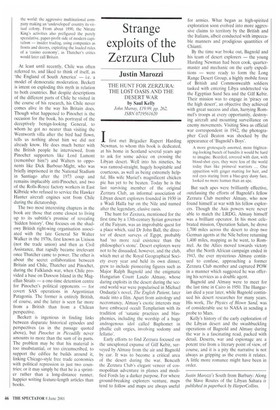Strange exploits of the Zerzura Club
Justin Marozzi
THE HUNT FOR ZERZURA: THE LOST OASIS AND THE DESERT WAR by Saul Kelly John Murray, £19.99, pp. 262, ISBN 0719561620 Ifirst met Brigadier Rupert Harding Newman, to whom this book is dedicated, at his home in Scotland several years ago to ask for some advice on crossing the Libyan desert. Well into his nineties, he was ramrod-straight, hugely hospitable and courteous, as well as being extremely helpful. His wife Muriel's magnificent chicken pie has yet to be beaten. Today he is the last surviving member of the original Zerzura Club, an informal association of Libyan desert explorers founded in 1930 in a Wadi Haifa bar on the Nile and named after the legendary, elusive oasis.
The hunt for Zerzura, mentioned for the first time by a 13th-century Syrian governor of the Faiyum, was an improbable quest for a place which, said Dr John Ball, the director of desert surveys of Egypt, probably had 'no more real existence than the philosopher's stone'. Desert explorers were not to be dissuaded, however, and the club, which met at the Royal Geographical Society every year and held its own dinner, grew to include pioneering figures such as Major Ralph Bagnold and the enigmatic Hungarian Count Laszlo Almasy, whose daring exploits in the desert during the second world war were popularised in Michael Ondaatje's novel. The English Patient, later made into a film. Apart from astrology and necromancy, Almasy's exotic interests may have embraced occult Templarism with its tradition of 'satanic practices and blasphemies, including the worship of a huge androgenous idol called Baphomet in phallic cult orgies, involving sodomy and fellatio'.
Early efforts to find Zerzura focused on the unexplored expanse of Gilf Kebir, surveyed by Almasy from the air and Bagnold by car. It was to become a critical area of the desert during the war. Beneath the Zerzura Club's elegant veneer of cosmopolitan adventure in planes and modified Fords lay a darker purpose. For where ground-breaking explorers venture, maps tend to follow and maps are always useful for armies. What began as high-spirited exploration soon evolved into more aggressive claims to territory by the British and the Italians, albeit conducted with impeccable manners and prodigious quantities of Chianti.
By the time war broke out, Bagnold and his team of desert explorers — the young Harding Newman had been cook, quartermaster and mechanic on the early expeditions — were ready to form the Long Range Desert Group, a highly mobile force of British and Commonwealth soldiers tasked with entering Libya undetected via the Egyptian Sand Sea and the Gilf Kebir. Their mission was to engage in 'piracy on the high desert', an objective they achieved with great success and elan, harrying Rommel's troops at every opportunity, destroying aircraft and mounting surveillance on enemy movements. Visiting Siwa as official war correspondent in 1942, the photographer Cecil Beaton was shocked by the appearance of `Bagnold's Boys'.
A more grotesquely assorted, more frightening-looking bunch of bandits it would be hard to imagine. Bearded, covered with dust, with blood-shot eyes, they were less of the world today than like primeval warriors ... One apparition with ginger matting for hair, and red eyes staring from a blue-grey dusty face, looked no more human than an ape.
But such apes were brilliantly effective, outclassing the efforts of Bagnold's fellow Zerzura Club member Almasy, who now found himself at war with his fellow explorers. Though the Axis powers were never able to match the LRDG, Almasy himself was a brilliant operator. In his most celebrated mission, Operation Salam, he drove 1,700 miles across the desert to drop two German agents at the Nile before returning 1,400 miles, mapping as he went, to Rommel. As the Allies moved towards victory after the North African campaign ended in 1943, the ever mysterious Almasy continued to confuse, approaching a former Zerzura Club member and captured POW in a manner which suggested he was offering his services as a double agent.
Bagnold and Almasy were to meet for the last time in Cairo in 1950. The Hungarian died a year later, while Bagnold continued his desert researches for many years. His work, The Physics of Blown Sand, was of considerable use to NASA in sending a probe to Mars.
Kelly's history of the early exploration of the Libyan desert and the swashbuckling operations of Bagnold and Almasy during the war is a fascinating read, packed with detail. Deserts, war and espionage are a potent trio from a literary point of view, of course, and it is a pity the narrative is not always as gripping as the events it relates. A little more romance might have been in order.
Justin Marozzi's South from Barbary: Along the Slave Routes of the Libyan Sahara is published in paperback by HarperCollins.






















































































 Previous page
Previous page